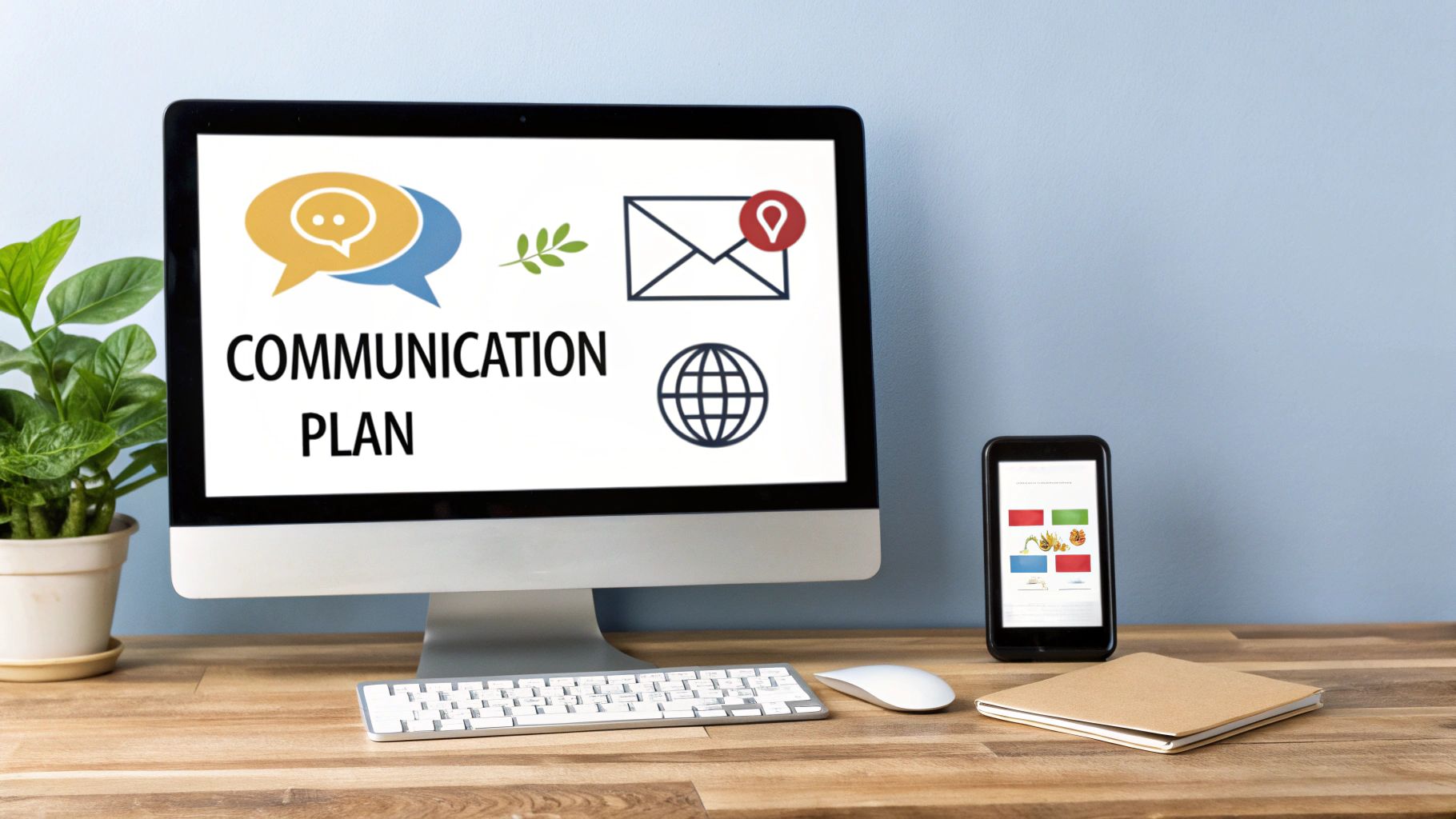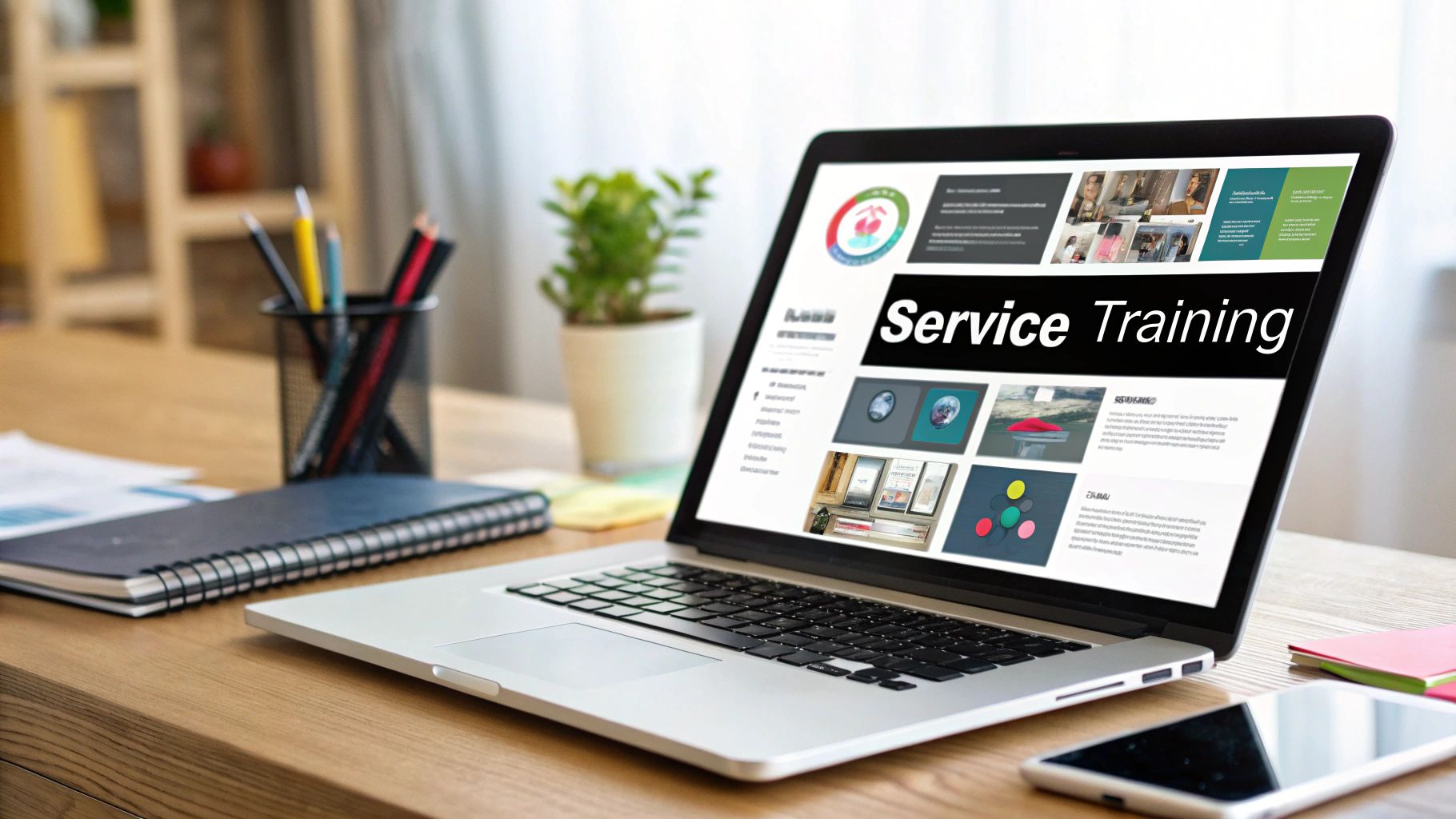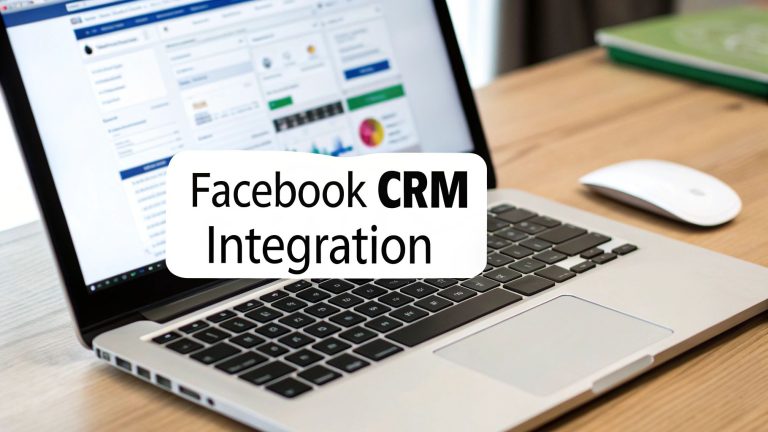Ultimate Client Onboarding Checklist for 2025
The journey from a promising lead to a loyal client is paved with crucial first steps. A haphazard onboarding process can quickly sour a new relationship, leading to misaligned expectations, scope creep, and ultimately, churn. Conversely, a structured, thoughtful client onboarding experience sets the stage for trust, collaboration, and long-term success. It's not just about paperwork and welcome emails; it's a strategic process that aligns goals, defines communication, and solidifies the value you promise to deliver.
This definitive client onboarding checklist breaks down the eight critical stages every business needs to master. From initial data collection to setting future success milestones, each step is designed to transform new customers into enthusiastic partners, ensuring you start every project on the strongest possible footing. For marketing agencies and sales teams, especially those managing leads from platforms like Facebook, getting this initial phase right is paramount. Automating the initial data transfer can kickstart this process instantly, eliminating manual entry errors and enabling your team to engage new clients faster and more effectively. Following this guide will help you build a repeatable system for creating flawless first impressions every single time.
1. Collect and Verify Client Information
The cornerstone of any successful client onboarding checklist is the systematic collection and verification of essential client information. This initial step goes beyond just gathering contact details; it's about building a comprehensive client profile that will guide the entire relationship. From legal documentation and business information to specific project requirements and stakeholder contacts, this process sets a foundation of clarity and compliance from day one.

A thorough data collection process ensures you have everything needed to deliver exceptional service while minimizing future roadblocks. For example, a marketing agency might collect brand guidelines, social media credentials, and competitor analysis, while a financial advisor would gather investment history and risk tolerance assessments through secure digital forms. Getting this right prevents frustrating back-and-forth communication later on.
Actionable Tips for Implementation
- Use Digital Forms: Implement smart digital forms with conditional logic. These forms adapt in real-time, showing only relevant fields based on a client's previous answers, which significantly reduces completion time and frustration.
- Create Document Checklists: Provide clients with a clear checklist of required documents (e.g., signed contracts, NDAs, business registration). For complex requirements, include brief explanations or examples for each item.
- Automate Reminders: Set up automated email or SMS reminders for clients who have submitted incomplete information or are approaching a deadline. This keeps the process moving without manual intervention.
To make this initial data capture as smooth as possible, you can borrow strategies from event organizers who excel at this. A well-structured guide to flawless online registration offers valuable insights into creating user-friendly forms and streamlining submissions. This proactive approach not only gathers necessary data but also provides an excellent first impression. Ultimately, accurate and complete information minimizes misunderstandings, ensures regulatory compliance, and enables your team to start delivering value immediately. To further ensure accuracy, you can find helpful advice on how to fix data entry errors and maintain a clean database from the start.
2. Define Project Scope and Expectations
A pivotal element in any client onboarding checklist is the clear definition of the project scope and mutual expectations. This step is about transforming abstract client goals into a concrete, actionable plan with defined boundaries. It involves meticulously outlining deliverables, setting realistic timelines, establishing key performance indicators (KPIs), and clarifying what is not included. This proactive alignment prevents scope creep, the silent killer of project profitability and timelines.

Without a clearly documented scope, a project can quickly spiral out of control with endless revisions and added requests. For example, a software development agency must create detailed technical specifications, while a creative agency should establish firm limits on revisions and define the approval process. This discipline ensures both parties share the same vision of success and understand the path to get there, fostering trust and a healthy working relationship from the outset.
Actionable Tips for Implementation
- Document Everything in a Scope Statement: Create a formal Scope of Work (SOW) document that details project objectives, deliverables, timelines, milestones, assumptions, and constraints. This document should be reviewed and signed by the client.
- Use Visual Timelines: Employ tools like Gantt charts or project roadmaps to visually represent the project schedule. This helps clients understand dependencies and key phases at a glance.
- Define "Done": Clearly articulate the criteria for project completion and what constitutes final sign-off. This avoids ambiguity about when your work is officially finished and payment is due.
Effectively defining the scope is often the central theme of the initial project meeting. For a deeper dive into structuring these critical early-stage conversations, you can explore resources on crafting the ultimate project kickoff meeting agenda. This will help you cover all necessary bases and set your project up for success. By establishing firm guardrails, you ensure your team can focus on delivering high-quality work within the agreed-upon parameters, which is fundamental to a positive client experience.
3. Establish Communication Protocols
A critical part of any client onboarding checklist involves establishing clear and structured communication protocols. This step is about proactively defining how, when, and where conversations will happen. By setting up designated channels, agreed-upon response times, and clear escalation paths, you create a transparent framework that manages expectations, prevents miscommunication, and builds trust from the outset.

Without a defined communication plan, you risk chaotic interactions, missed messages, and client frustration. For instance, a digital agency might create a dedicated Slack channel for daily updates but reserve email for formal approvals and schedule weekly video calls for strategic reviews. This multi-channel approach ensures that every type of communication has a proper home, streamlining the entire workflow and reinforcing a professional, organized partnership.
Actionable Tips for Implementation
- Create a Communication Charter: Document all communication agreements in a simple charter or guide. This document should outline preferred channels (e.g., Slack, email, project management tool), key contacts for different issues, and expected response times.
- Establish a Clear Meeting Cadence: Schedule recurring meetings (daily, weekly, or bi-weekly) with standardized agendas. This creates a predictable rhythm for status updates and strategic discussions, ensuring everyone stays aligned without constant ad-hoc check-ins.
- Define Emergency Procedures: Clearly outline what constitutes an emergency and provide a specific contact method for urgent situations that require immediate attention outside of normal business hours. This gives clients peace of mind and protects your team's work-life balance.
4. Assign Dedicated Team Members and Points of Contact
After gathering information and finalizing agreements, the next critical step in your client onboarding checklist is to humanize the business relationship. Designating specific team members with defined roles provides clients with clear points of contact, fostering accountability and ensuring smooth communication. This transition from a faceless company to a team of dedicated experts builds trust and sets a collaborative tone for the entire engagement.
A well-defined team structure prevents client confusion and internal chaos. For example, an IT consulting firm might assign a technical lead for system architecture, a business analyst for requirements gathering, and a client success manager for overall satisfaction. This clarity ensures that when a client has a specific question, they know exactly who to turn to, which speeds up response times and improves the overall service experience.
Actionable Tips for Implementation
- Create Team Introduction Materials: Develop a brief, visually appealing document or slide deck that introduces the key team members. Include their photo, role, specific responsibilities, and a short bio highlighting their expertise.
- Establish Clear Escalation Paths: Document and share a simple hierarchy or flowchart showing who the client should contact if their primary point of contact is unavailable or if an issue needs to be escalated.
- Schedule a "Meet the Team" Call: A brief introductory video call allows clients to put faces to names and ask initial questions. This personal touch is far more effective than a simple email introduction.
- Plan for Succession: Proactively plan for potential team changes. Document key processes and client knowledge in a centralized location to ensure seamless knowledge transfer and service continuity if a team member leaves.
By formally assigning roles, you not only improve efficiency but also strengthen the client bond. This structured approach to relationship building is a core principle in modern business, and you can explore more about customer relationship management basics to refine these interactions further. Ultimately, a clearly introduced and well-organized team reassures clients that they are in capable hands, ready to achieve their goals together.
5. Provide Comprehensive Service Overview and Training
A critical component of any effective client onboarding checklist is educating your new clients on how to best work with you. This involves providing a comprehensive overview of your services, processes, and the tools you'll use together. This step is about empowerment; it transforms clients from passive recipients into active, informed partners who can contribute effectively to the project's success and extract maximum value from your relationship.

When clients understand the "how" and "why" behind your methods, collaboration becomes smoother and more productive. For instance, a web development agency might train a client on their new content management system (CMS), while a SaaS company like HubSpot or Salesforce uses extensive training academies to ensure users are proficient. This proactive education minimizes confusion, reduces support requests, and sets clear expectations for communication and project milestones.
Actionable Tips for Implementation
- Create Modular Training Content: Develop training materials that can be customized for different client needs and sophistication levels. A beginner might need a basic walkthrough, while an advanced user could benefit from a deep dive into specific features.
- Use Multiple Learning Formats: Cater to different learning styles by offering a mix of formats. Combine live webinars, pre-recorded video tutorials, detailed documentation, and hands-on practice sessions to reinforce key concepts.
- Build a Searchable Knowledge Base: Develop a centralized, searchable resource like an FAQ section or knowledge base. This allows clients to find answers to common questions independently, saving time for both parties.
- Provide Quick Reference Guides: Create one-page "cheat sheets" or quick reference guides that summarize crucial information, such as key contacts, important links, or core processes.
Effective training is not a one-time event but an ongoing process that builds client confidence and competence. For a masterclass in creating engaging and scalable educational content, look no further than the best practices demonstrated by industry leaders.
By investing in client education upfront, you foster a more collaborative and successful partnership. This approach not only improves client satisfaction but also increases the likelihood of long-term retention and referrals. An educated client is an empowered partner, capable of making informed decisions that drive better results.
6. Set Up Systems Access and Integration
Once the foundational information is gathered and the kickoff meeting is complete, the next critical step in a comprehensive client onboarding checklist is to configure all necessary technical access and system integrations. This stage involves creating the digital infrastructure that allows your team and the client’s team to collaborate seamlessly. Properly setting up these connections is essential for sharing data, managing workflows, and executing project tasks efficiently, thereby removing technical friction from the start.
This process varies significantly depending on your industry and services. For example, a marketing agency might require access to a client’s Google Analytics, social media ad accounts, and CRM. In contrast, an IT consultancy may need to set up VPN access and permissions for a client’s development environment. Getting these integrations right early on prevents delays and ensures your team has the tools they need to deliver results without constant back-and-forth requests for credentials.
Actionable Tips for Implementation
- Implement Role-Based Access Control: To enhance security, grant access based on team members' specific roles. An analyst may only need 'view' permissions for a client's analytics platform, while a project manager might require 'editor' or 'admin' rights. This minimizes the risk of unauthorized changes.
- Document and Test All Connections: Create a secure, centralized document listing all access credentials, API keys, and integration points. Before the project officially starts, thoroughly test every connection to confirm it functions as expected and that data is flowing correctly.
- Schedule Regular Access Reviews: Plan periodic reviews, such as quarterly or bi-annually, to audit who has access to what systems. This is a crucial security practice to remove permissions for former employees or team members who have changed roles, protecting both your agency and the client.
A smooth technical setup is a hallmark of a professional onboarding experience. For teams working on complex software projects, establishing clear guidelines for the development environment is key. You can learn from best practices on how to set up your local development environment to ensure consistency across your team. Ultimately, a well-integrated technical environment empowers your team to work efficiently and demonstrates your firm's technical competence, building client confidence from day one.
7. Create and Review Legal Agreements
A critical component of any professional client onboarding checklist is formalizing the business relationship through comprehensive legal agreements. This step moves the partnership from a verbal understanding to a legally binding commitment, protecting both you and your client. By creating and meticulously reviewing contracts, service-level agreements (SLAs), and non-disclosure agreements (NDAs), you establish clear expectations, define the scope of work, and outline recourse for potential disputes.
This legal framework is not just a formality; it's a strategic tool for risk management and clarity. For instance, a software company will use a SaaS agreement to detail data processing terms and user obligations, while a creative agency’s contract will specify intellectual property ownership and usage rights. Establishing these boundaries from the start prevents scope creep, payment disputes, and misunderstandings about deliverables, ensuring a transparent and professional engagement.
Actionable Tips for Implementation
- Use Agreement Templates: Develop pre-approved contract templates for your most common services or engagement types. This speeds up the process and ensures consistency, but remember to customize key details like scope and payment terms for each new client.
- Schedule a Contract Walk-Through: Dedicate a specific meeting or call to review the legal documents with your client. Use this time to explain key clauses in plain language and answer any questions they have, which builds trust and ensures everyone is on the same page.
- Implement E-Signature Systems: Adopt electronic signature platforms like DocuSign or PandaDoc to streamline the signing process. This modern approach is faster, more secure, and provides a clear audit trail, getting your project kicked off without delay.
The importance of clear, well-structured agreements is emphasized by organizations like the International Association for Contract & Commercial Management (IACCM), which advocates for contracts that are easy to understand and aligned with business outcomes. By treating legal agreements as a foundational part of the relationship rather than a hurdle, you set a precedent for clear communication and mutual respect. To ensure your agreements are robust, you can review best practices for creating a statement of work to complement your primary contract.
8. Schedule Follow-up and Success Milestones
A successful client onboarding checklist doesn't end when the initial setup is complete; it transitions into a structured framework for long-term success. Scheduling regular follow-ups and defining success milestones transforms the relationship from a one-time transaction into a strategic partnership. This proactive step ensures continuous alignment, provides opportunities to demonstrate value, and keeps the client engaged and invested in the process.
Establishing this cadence from the outset manages expectations and creates a predictable rhythm of communication. For instance, a digital marketing agency might schedule monthly performance reviews to analyze ROI and campaign data, while a software development team would conduct bi-weekly sprint reviews to gather stakeholder feedback. This forward-thinking approach proves that you are committed to the client's goals beyond the initial sale, cementing trust and paving the way for sustained value delivery.
Actionable Tips for Implementation
- Align Meeting Cadence: Match the frequency of your check-ins to the project's complexity and the client's preference. A high-intensity, short-term project may require weekly touchpoints, whereas a long-term retainer might only need quarterly business reviews.
- Prepare Structured Agendas: Never go into a meeting without a plan. Send a clear, concise agenda beforehand with specific discussion points, performance data, and desired outcomes. This respects everyone's time and keeps the conversation focused.
- Visualize Performance Data: Use charts, graphs, and dashboards to make performance reports engaging and easy to understand. Visual data is far more effective at communicating progress and highlighting key achievements than raw numbers in a spreadsheet.
- Formalize Action Items: Conclude every meeting by defining clear action items, assigning owners, and setting deadlines. This creates accountability and ensures that discussions translate into tangible progress.
By setting these milestones, you create a roadmap for the client relationship, ensuring both parties are on the same page about what success looks like and how it will be measured. For more detailed strategies on maintaining this momentum, exploring lead follow-up best practices can provide valuable frameworks for structuring these critical conversations. Ultimately, this part of your client onboarding checklist guarantees that the initial momentum is not lost, fostering a partnership built on transparency, accountability, and measurable results.
Client Onboarding Checklist Comparison
| Item | Implementation Complexity 🔄 | Resource Requirements ⚡ | Expected Outcomes 📊 | Ideal Use Cases 💡 | Key Advantages ⭐ |
|---|---|---|---|---|---|
| Collect and Verify Client Information | Moderate – requires secure data handling | Medium – digital forms, verification tools | Accurate client data, compliance, trust | Legal, financial, SaaS, marketing | Reduces errors, ensures compliance, builds credibility |
| Define Project Scope and Expectations | High – detailed planning and documentation | High – project management, team involvement | Clear deliverables, budget control, scope management | Software, consulting, construction, creative agencies | Prevents scope creep, defines accountability, enables resource planning |
| Establish Communication Protocols | Moderate – setup of channels and schedules | Low to medium – communication platforms | Improved client satisfaction, reduced miscommunication | Agencies, consultants, freelancers, software companies | Sets expectations, improves responsiveness, creates accountability |
| Assign Dedicated Team Members and Points of Contact | Moderate – role definition and coordination | Medium – team assignment and management | Strong client relationships, continuity, expertise | Agencies, consulting, legal, financial services | Builds trust, ensures expertise access, improves knowledge retention |
| Provide Comprehensive Service Overview and Training | High – content creation and delivery | High – training sessions, materials | Increased client engagement, reduced support needs | SaaS, marketing, financial advisory, development firms | Enhances client knowledge, reduces confusion, demonstrates value early |
| Set Up Systems Access and Integration | High – technical configuration and security | High – IT resources, security measures | Seamless collaboration, data sharing, audit compliance | Marketing, IT consulting, accounting, e-commerce | Enables real-time data sharing, reduces manual work, improves transparency |
| Create and Review Legal Agreements | Moderate to high – legal drafting and approval | Medium to high – legal expertise | Legal protection, defined rights and obligations | Software companies, consulting, creative agencies, financial | Protects parties, clarifies terms, manages disputes |
| Schedule Follow-up and Success Milestones | Moderate – ongoing scheduling and analysis | Medium – meetings, reporting tools | Continuous improvement, client retention, upselling | Marketing, software development, consulting, financial | Proactive issue resolution, commitment demonstration, performance tracking |
Turning Your Checklist into a Competitive Advantage
Moving through this comprehensive client onboarding checklist might seem like a series of administrative hurdles, but its true value lies in its transformative power. This isn't just about ticking boxes; it's about architecting a robust foundation for every client relationship. A meticulously executed onboarding process is your first, and best, opportunity to demonstrate competence, build trust, and set the stage for a profitable, long-term partnership.
The journey from initial contact to a fully integrated client is where potential friction points are neutralized and expectations are perfectly aligned. By systematically addressing everything from verifying information and defining project scope to establishing clear communication protocols and setting up system access, you create a repeatable engine for success. This structured approach moves your client from a state of uncertainty to one of confident collaboration. Remember, the core of a great onboarding experience is proactive communication and mutual understanding.
From Checklist to Strategic Asset
Transforming this list into a strategic asset requires a shift in perspective. View each step not as a task, but as a crucial building block in the client relationship.
- Defining Scope and Expectations: This isn't just about project management; it's about preventing scope creep and ensuring you and your client share the same definition of success.
- Establishing Communication Protocols: This step minimizes confusion and frustration, ensuring information flows efficiently to the right people at the right time.
- Scheduling Success Milestones: This goes beyond simple check-ins. It creates a framework for demonstrating value, gathering feedback, and reinforcing the client's decision to partner with you.
Mastering this client onboarding checklist allows your team to operate from a position of strength and clarity, which directly translates into higher client satisfaction and retention. It becomes your competitive advantage in a crowded marketplace.
Actionable Next Steps for Immediate Impact
The most effective way to begin is by auditing your current process against the framework we've outlined. Identify the one or two areas that represent the biggest gaps or opportunities for improvement. Perhaps your legal agreements are inconsistent, or your systems access setup is consistently causing delays.
Focusing your efforts on these critical points will yield the most significant returns. As you refine these stages, consider where automation can remove repetitive, low-value work. For instance, for businesses running Facebook ad campaigns, the initial step of collecting lead information can be a major bottleneck. Using a tool to automate this data transfer frees up your sales or account teams to focus on building rapport rather than manual data entry. For a deeper dive into making your onboarding process exceptional, explore these essential customer onboarding best practices.
Ultimately, a world-class onboarding experience reassures clients that they made the right choice. It proves your organization is professional, organized, and truly invested in their success. This initial investment of time and resources pays dividends through smoother projects, fewer emergencies, and clients who become your most vocal advocates.
Ready to automate the very first step of your client onboarding? LeadSavvy Pro instantly syncs new leads from your Facebook Lead Ads to your CRM or Google Sheets, eliminating manual data entry. Start every new client relationship with speed and efficiency by trying LeadSavvy Pro today.







